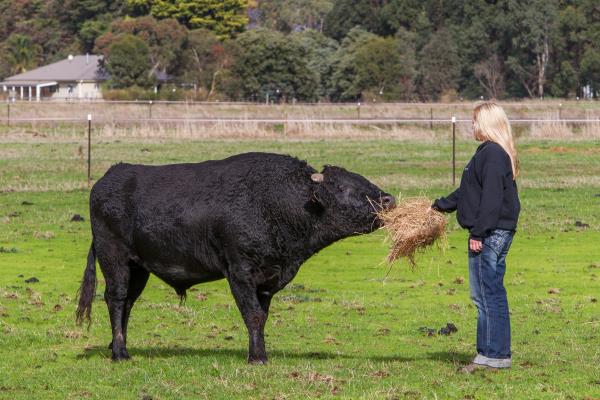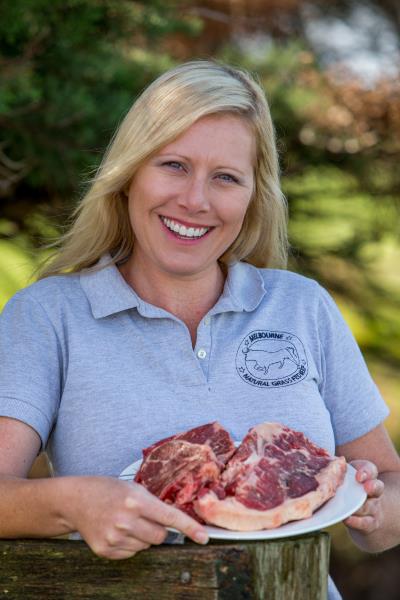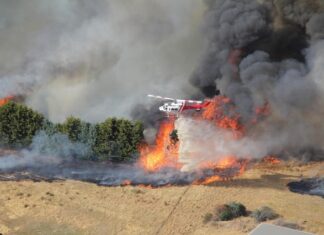Cattle rearing is a business built on years of tried and tested farming practices, though one Nar Nar Goon farmer is doing things a bit differently. Owning and operating her own ‘paddock to plate’ farm, ELLIE MITTERER explains her unique idea to KATHRYN BERMINGHAM.
“I breed them and I know what I breed them for, but I don’t believe that when they’re alive they should just be treated like something to be consumed.”
ELLIE MITTERER lives most of her life in a paddock surrounded by cattle – and that’s just the way she likes it.
She owns Melbourne Natural Grass Fed Beef, a farming venture which offers customers the opportunity to buy bulk, grass-fed beef directly from the farm, eliminating the supermarket mark-up.
Born in Berwick and raised with chickens and a dog, farming was a good fit for a girl who has always had a love for horses and cows.
“I’ve always really liked beef cattle. By my late teens I knew I wanted to farm and by my late twenties I knew I wanted to farm cattle.”
At 31, she brought her Nar Nar Goon property and started buying cows. The years since have brought with them challenges and triumphs.
“It’s been all go in the way of learning about cattle management and breeding.
“I knew I wanted a wagyu bull and wagyu is traditionally lot fed, which I don’t believe is necessarily kind on the animal or producing a healthy product.
“I believe that grass fed is healthier, and so I thought I’ll try something different and rear a grass-fed wagyu.
“It’s kinder to the animal and better to the environment, so it was a really easy decision to make.”
The next challenge was finding a market for such the product, which Ellie said has been somewhat difficult.
She offers the beef of a black angus in her budget pack, with the Wagyu beef classed as premium. Distribution is also a finely tuned process.
“One beast usually goes between 14 and 16 packs, so I have to co-ordinate 14 to 16 customers and it’s got to go out on the day because I can’t store the meat.”
From its birth, throughout it life right up to the moment it is presented to the customer, Ellie takes great care in ensuring she provides a high quality product.
Throughout their life, the cows are grazed on her property. They are regularly rotated and given premium feed to maintain optimum health.
Her cattle are “quiet and manageable”, which she attributes to their upbringing.
It’s a delicate balance in treating the cows with dignity yet not growing attached before they meet their inevitable end.
Over the years, she has developed a set routine in the way she handles her cattle.
“I breed them and I know what I breed them for, but I don’t believe that when they’re alive they should just be treated like something to be consumed,” she said.
“They shouldn’t be treated like a commodity, they should be treated like a living animal.
“I don’t get attached but I enjoy them.”
When Ellie deems them ready, they are transported to the abattoir.
“I take them there myself. I don’t want them to go on a trailer or a truck where somebody else might jab it with an electric prod.
“When it gets there it will stay in a pen until morning and when the time comes we make sure there is minimal stress on the animal,” she said.
Once the body temperature of the cattle has cooled down to around six degrees, it is loaded onto a PrimeSafe certified truck and then sent to a butcher.
“The butcher hangs it for a couple of weeks, packs it and dresses it. He slices it into usually two steaks per pack, bags of mince or sausages – the packs will vary depending on the beast.”
Cuts available from the butcher include eye fillet, scotch fillet, rump steak, round steak, top side roast, silverside, T-bone, blade roast and chuck steaks and the butcher can provide mince, diced meat and stir fry strips.
After the butcher has packed, bagged and labelled it, Ellie collects the meat, which can be about 160 kilograms when dressed.
She delivers all of the meat in one day in her PrimeSafe certified refrigerated van.
“Delivery day is my social day,” she said.
“I love getting out and meeting people, asking about recipes and getting feedback.”
Her customers usually buy one bulk pack every three months, with discounts offered for big groups.
She finds they return, and bring more friends and family – for good reason. The list of benefits of grass fed beef is long.
“You’ll notice the difference.
“My cows aren’t lot-fed, meaning they don’t stand in small paddocks and get fed rubbish to make them fat quickly.
“We eat beef because they can digest cellulose – they’re ruminants, they’ve got four stomachs.
“They can digest hay and grass and they can draw from it vitamins that we can get ourselves.”
As well as a higher nutritional content, there are also physical differences between lot-fed and grass-fed beef.
A life of roaming and grazing means there is more texture in beef that has been raised eating grass.
There are also differences in the fat consistency.
“You often notice with a grass-fed beast there’s a buttery coloured fat, which is very important because your fat-soluble vitamins are in that fat,” Ellie explains.
“So if an animal is fed rubbish they’re going to be storing toxins and they’ll have a white coloured fat beside a grass-fed beef which has a more yellow fat.
“It’s also much nicer in flavour and juicier.”
For Ellie, life can get pretty hectic. She’s now been running the business for approximately two years, but due to building difficulties does not yet live on the property.
“I’m hoping to move in within the next few months, but until then I’ll be up there every day making sure everything’s running smoothly. There’s always something to do.”
It’s a sentiment that rings true, with 80-90 heads of cattle now grazing on the farm. Between maintaining the cows and looking after the land, she spends at least a few hours there each day.
“You have to completely commit to the lifestyle, but I wouldn’t have it any other way.”












